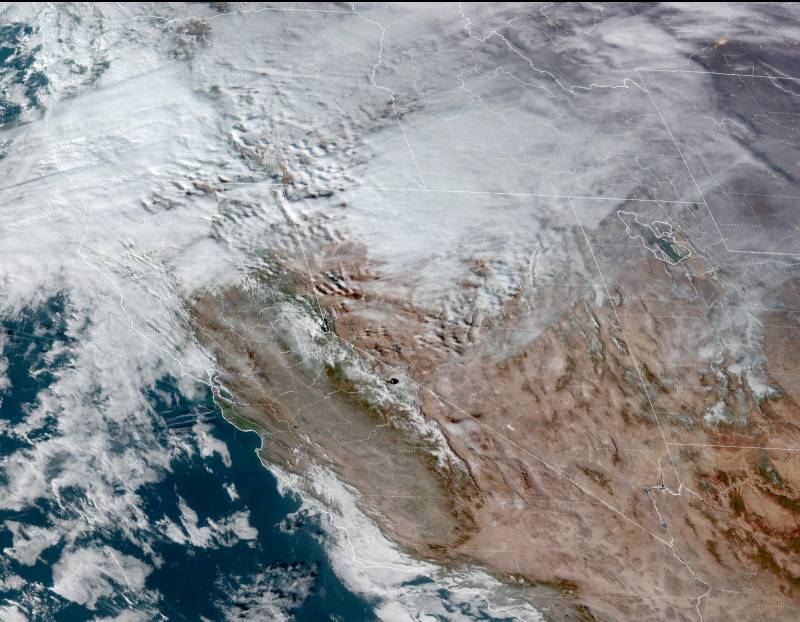Most parts of the Bay Area will receive up to 1.5 inches of rain on Thursday, paired with 30–45 mph wind gusts and temperatures dropping into the 40s, before clearing up by Friday. A second but weaker system is expected to bring more rain Friday night through Sunday.
“This is really kind of the first typical winter storm that we’ve had for the season,” said Garcia. “We’ve had a couple other fronts roll through and bring us a little bit of rain. But this one kind of brings it all with the wind, the rain and the cold temperatures following.”
The coldest weather is forecast for early Friday morning after the storm has passed, with temperatures expected to dip into the mid-30s to low-40s throughout most of the Bay Area, before rising into the mid-to-high 40s by Saturday.
Amid the imminent cold, wet conditions, local officials and service providers are scrambling to temporarily expand access to warming centers and other shelters for the thousands of unsheltered people living throughout the Bay Area who remain uniquely vulnerable to harsh weather conditions.
In San Francisco, with an unhoused population of nearly 8,000, finding shelter in the rain and the expected 40-degree lows on Thursday and Friday nights will prove crucial, with various temporary shelters and warming centers available for those exposed to the elements.
“Our Homeless Outreach Team is expanding our work today through the weekend,” said Emily Cohen, spokesperson for the San Francisco Department of Homelessness and Supportive Housing. “We’ll be conducting wellness checks throughout the city, handing out emergency blankets, checking for symptoms of hypothermia, talking to folks and inviting them into shelter or directing them to the nearest warming centers.”
Cohen adds that San Francisco public libraries will be open during the day and that the city will be expanding its shelter capacity at three sites — Sanctuary, MSC South and Next Door Shelter — where people will be able to self-refer and request a shelter bed to stay overnight. People can also go to locations of the Interfaith Winter Shelter, a roving shelter that goes to different faith congregations throughout the city.
“We certainly do not have shelter beds for every person experiencing homelessness in our community,” said Cohen, regarding capacity at the shelters. “We estimate that we have over 7,700 people experiencing homelessness in our community on any given night. But on any given day, we tend to have enough vacancies within the system to make offers of shelter to people living outside. The outreach team is equipped daily with shelter beds, and they go out and offer them to folks living outdoors. And if folks accept those offers, we will facilitate their immediate placement.”
In Santa Clara County — home to more than 10,000 unhoused residents — temperatures in some places are expected to drop to the low 30s on Thursday night, spurring officials to convert libraries and various other community facilities into warming centers for the most vulnerable residents, with free transportation also available.
The county on Monday also opened a temporary overnight shelter program in Mountain View — at Los Altos United Methodist Church — for women and families that is scheduled to operate daily from 3 p.m. to 9 a.m. through March.
“People need a place to go, particularly when it’s cold and wet outside,” said Santa Clara County Supervisor Joe Simitian, who proposed the shelter years ago. “It’s as simple as that.”
Farther north, in Santa Rosa, where some 1,650 residents are experiencing homelessness, city officials on Tuesday night opened a temporary warming center — at Catholic Charities’ new downtown Caritas Center — which is expected to remain open until at least Thursday morning. In Marin County, Marin Health and Human Services is opening the shelter from 3 p.m. Friday to 10 a.m. Saturday at 3240 Kerner Blvd. in San Rafael. People are encouraged to sign in by 8 p.m. Friday.
In Sonoma County, a freeze warning was issued Wednesday as overnight temperatures are expected to drop to as low as the upper 20s and lower 30s through Monday, which could result in snow and black ice, according to county officials. The county advised unhoused residents to locate the nearest shelter, all of which operate on a first-come, first-served basis, with many offering wraparound services. The city of Sonoma will be extending its temporary shelter at the Sonoma Veterans Memorial Building for Friday evening through Saturday morning. The veterans building is located at 126 First St. W. and will be open from 7 p.m. Friday to 9 a.m. Saturday.
In Vallejo, an overnight winter warming shelter that had opened on Thursday evening has been extended through Friday evening at the Norman C. King Recreation Center at 545 Magazine St. from 8 p.m. Friday until 7 a.m. Saturday. People looking to get out of the cold are encouraged to bring their own sleeping bags or blankets. Space is limited, so entrants are also asked to only bring one small bag of personal items.
The storm is also forecast to dump a heavy layer of snow on the Tahoe region and much of the Sierra, with wind gusts reaching 100 mph on ridges and mountaintops.
The National Weather Service has issued a winter storm warning for much of the Sierra that starts at 10 p.m. Wednesday and stretches into Friday, with the heaviest snowfall expected at Tahoe on Thursday, when as much as 3 inches an hour could produce whiteout conditions on Thursday.
“Travel will be very difficult with hazardous conditions,” the NWS said Wednesday. “Strong winds could cause damage to trees and lead to power outages.”
Between 10 and 20 inches of snow is forecast around Lake Tahoe, with 1 to 2 feet at elevations above 7,000 feet.
See lists of warming centers and emergency shelters in:
This story includes reporting from KQED’s Matthew Green, Ezra David Romero and The Associated Press.
